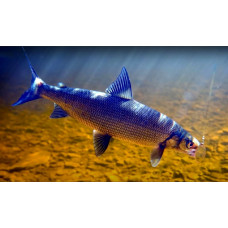Soregonidae is a family of fishes of the Salmoniformes. Body coloration is uniform, silvery, no spots. Scales are large. There is an adipose fin. Teeth are poorly developed or completely absent. Eggs are small, yellow, laid on the ground, but not buried. Widespread in the waters of Europe, Asia and North America. Includes 3 genera: whitefish, nelma, walleye. The genus Shiga (Coregonus) is the most numerous. It distinguishes forms with upper, terminal and lower mouth. Passable, semipassable, lake and river forms. Planktonophagous, benthosophagous and predatory. Fish of small, medium and large sizes, body length from 16 cm to 130 cm and weight 0.025-50 kg. All whitefish are important targets for fishing and acclimatization.
Large or small fish with an elongated body, well-developed lateral line, rather large scales and fat fin. As a rule, they are uniformly colored: the sides of the body are silvery, without spots. These fish live in the basins of the Arctic Ocean, North Atlantic and Pacific Ocean, both in Eurasia and North America. By their way of life they are extremely diverse: there are among the whitefish passing, river and lake forms that feed on small organisms of the upper layers of water, there are lovers of bottom food, there are partial predators, fast- and slow-growing forms. Usually whitefish are divided into groups of species with different mouth positions.
Upward-facing whitefish are usually small fish that feed mainly on small invertebrate animals in the upper layers of water. This group is represented by the European grouper (Coregonus albula) inhabiting the lakes of the Baltic, Barents and White Seas and the upper Volga River basins and the Siberian grouper (C. sardinella), which is usually found in Siberian rivers (from the Kara to the Bering Sea), in the White Sea basin and in Kamchatka. The Siberian grouse is larger than the European grouse, reaches a length of more than 40 cm, usually fattens at the junction of fresh and salt waters in estuaries, and is rarely found in lakes. The largest form of the European ruffed grouse - "ripus" - lives in deep cold-water lakes, reaches a length of 34 cm and a weight of 460 g. The typical form lives in shallow lakes, its average length is 16 cm and weight is 25-50 g. All European ruffed grouse are important targets for fishing. All grouse are important commercial fisheries.
The whitefish with a "terminal", forward-facing mouth are important commercial fish. Omul (C. autumnalis) inhabits the Arctic Ocean rivers from Mezen to Chaun Bay. It is a large (length up to 64 cm and weight up to 3 kg) semi-passable fish, fattening in the bays and estuaries of the sea and rising to spawn along the rivers for 1000 and more kilometers. It feeds mainly on crustaceans and young fish. Lake Baikal is inhabited by resident lake-river whitefish - Baikal Omul (C. migratorius), which forms several herds breeding in different rivers. In the mouth of the Chegitun River, which flows into the Chukchi Sea, the Beringian Omul (C. laurettae), a semipassable species close to the common omul, widespread along the Pacific coast of Alaska, was recently discovered for the first time. The pelad, or cheese (C. peled) lives in rivers and lakes (from Mezen to Kolyma), but does not enter the sea water. In lakes it feeds mainly on crustaceans in the upper layers of water, spawns in the places where the keys come out. The pelada reaches a length of 55 cm with a weight of 2.5-3, rarely 4-5 kg. It is acclimatized in many lakes of northwestern Russia and in water bodies of the Southern Urals. Tugun (C. tugun) inhabits Siberian rivers from Ob to Yana, never goes to sea, feeds on small crustaceans, insects falling on the water, their larvae and eggs of other fish, reaches a length of 20 cm.
Whitefish with lower mouth include 7 species inhabiting Russian waters. It should be noted, however, that the great diversity of forms among whitefish, especially pronounced in this group, makes it very difficult to divide them into species, the number of which may be significantly revised in the future.
Coregonidae
Tags: coregonidae



